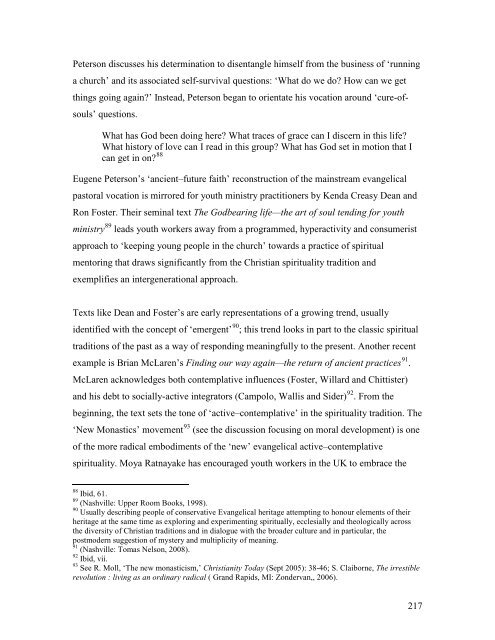Introductory notes for readers of this thesis - Theses - Flinders ...
Introductory notes for readers of this thesis - Theses - Flinders ...
Introductory notes for readers of this thesis - Theses - Flinders ...
You also want an ePaper? Increase the reach of your titles
YUMPU automatically turns print PDFs into web optimized ePapers that Google loves.
Peterson discusses his determination to disentangle himself from the business <strong>of</strong> ‘runninga church’ and its associated self-survival questions: ‘What do we do? How can we getthings going again?’ Instead, Peterson began to orientate his vocation around ‘cure-<strong>of</strong>souls’questions.What has God been doing here? What traces <strong>of</strong> grace can I discern in <strong>this</strong> life?What history <strong>of</strong> love can I read in <strong>this</strong> group? What has God set in motion that Ican get in on? 88Eugene Peterson’s ‘ancient–future faith’ reconstruction <strong>of</strong> the mainstream evangelicalpastoral vocation is mirrored <strong>for</strong> youth ministry practitioners by Kenda Creasy Dean andRon Foster. Their seminal text The Godbearing life—the art <strong>of</strong> soul tending <strong>for</strong> youthministry 89 leads youth workers away from a programmed, hyperactivity and consumeristapproach to ‘keeping young people in the church’ towards a practice <strong>of</strong> spiritualmentoring that draws significantly from the Christian spirituality tradition andexemplifies an intergenerational approach.Texts like Dean and Foster’s are early representations <strong>of</strong> a growing trend, usuallyidentified with the concept <strong>of</strong> ‘emergent’ 90 ; <strong>this</strong> trend looks in part to the classic spiritualtraditions <strong>of</strong> the past as a way <strong>of</strong> responding meaningfully to the present. Another recentexample is Brian McLaren’s Finding our way again—the return <strong>of</strong> ancient practices 91 .McLaren acknowledges both contemplative influences (Foster, Willard and Chittister)and his debt to socially-active integrators (Campolo, Wallis and Sider) 92 . From thebeginning, the text sets the tone <strong>of</strong> ‘active–contemplative’ in the spirituality tradition. The‘New Monastics’ movement 93 (see the discussion focusing on moral development) is one<strong>of</strong> the more radical embodiments <strong>of</strong> the ‘new’ evangelical active–contemplativespirituality. Moya Ratnayake has encouraged youth workers in the UK to embrace the88 Ibid, 61.89 (Nashville: Upper Room Books, 1998).90 Usually describing people <strong>of</strong> conservative Evangelical heritage attempting to honour elements <strong>of</strong> theirheritage at the same time as exploring and experimenting spiritually, ecclesially and theologically acrossthe diversity <strong>of</strong> Christian traditions and in dialogue with the broader culture and in particular, thepostmodern suggestion <strong>of</strong> mystery and multiplicity <strong>of</strong> meaning.91 (Nashville: Tomas Nelson, 2008).92 Ibid, vii.93 See R. Moll, ‘The new monasticism,’ Christianity Today (Sept 2005): 38-46; S. Claiborne, The irrestiblerevolution : living as an ordinary radical ( Grand Rapids, MI: Zondervan,, 2006).217















